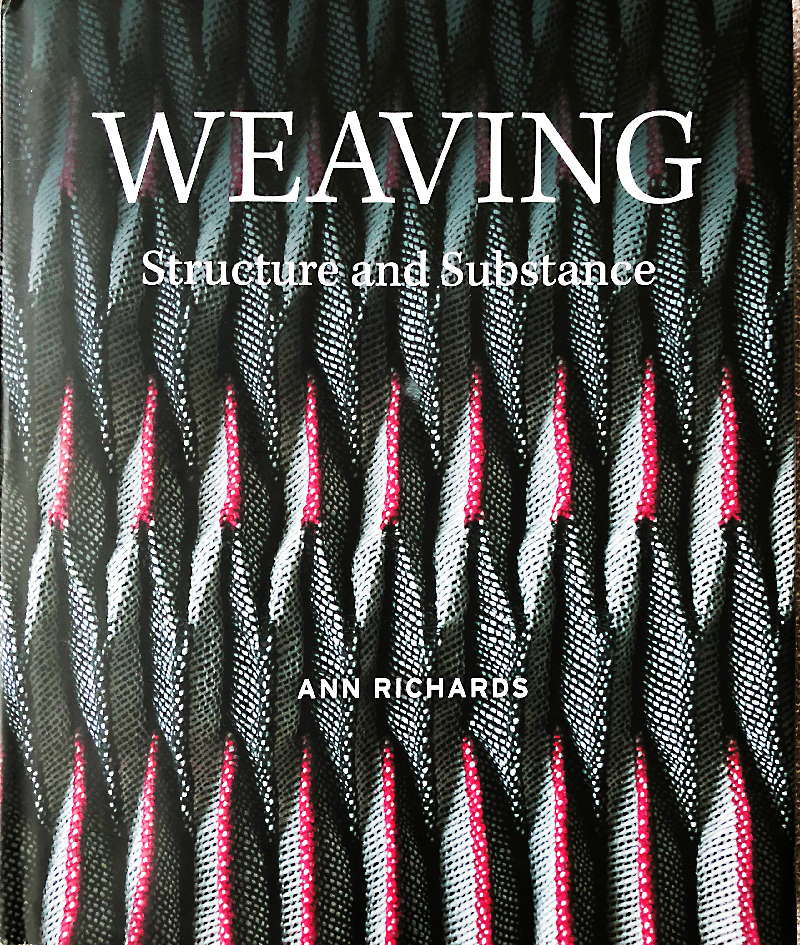
Ann Richards : Weaving – Structure and Substance
Als ich das erste Buch ” Weaving Textiles That Shape Themselves” von Ann Richards im Textile Forum 2/2012 auf Seite 44 besprach, schrieb ich, dass es sich um die interessanteste Lektüre zum Handweben handelte, die mir in den letzten Jahren begegnete! Im Jahr 2020 ist dann noch das wunderbare Buch “Thread Magic” von der dänischen Weberin Lotte Dalgaard (und Paulette Adamson) auch zum Thema der Weberei mit aktiven und passiven Fäden erschienen und wurde in diesem Blog besprochen.
Im neuesten Buch von Ann Richards werden weitere Entwicklungen und das Zusammenspiel von Material und Struktur gezeigt. Sie schreibt:” Textilien besitzen notwendigerweise strukturelle Qualitäten und tiefere haptische Eigenschaften – sie haben Substanz. Solchen Aspekten wird oft weniger Beachtung geschenkt, als sie verdienen, obwohl alle Weber wissen, dass sie für den Erfolg unerlässlich sind … Die Webstruktur ist entscheidend für den Entwurf von gewebten Textilien, aber da sie einfach nur aus einem Bindungsplan besteht, gibt sie an sich nicht vor, wie der Stoff aussehen wird”.
In Kapitel 5 über Rippen- und Faltengewebe sagt die Autorin etwas über ihre Motivation; dass sie, als sie selbst noch eine Anfängerin im Spinnen und Weben war, zufällig ein Faltengewebe produziert hatte. Ihre Faszination über diesen Effekt hat sie in ihrem ersten Buch “Weaving Textiles That Shape Themselves” beschrieben. Später hat sie für eine niederländische Archaeologin ein Replikat eines 2000 Jahren alten Rippenköpers hergestellt, und dabei erfahren, wie alt diese Art von Gewebe ist!
Das Buch ist in vier Teile gegliedert, die sich mit der Natur als Inspiration, den gestalterischen Möglichkeiten von Material und Gewebestruktur, den Stoffqualitäten als Ausgangspunkt für die Gestaltung und den praktischen Fragen des Gestaltens durch das Weben selbst auseinandersetzen.
Jedes Teil ist in Kapitel unterteilt, die das Thema vertiefen und praktische Beispiele zeigen von namhaften Webkünstlern und Webdesignern wie Reiko Sudo, Ann Sutton, Junichi Arai, Tim Parry-Williams, Deidre Wood, Lotte Dalgaard, Berthe Forchhammer, Stacey Harvey-Brown, Andreas Möller und viele mehr. Ebenso werden Aussagen von bekannten Webern und Weberinnen zitiert, zum Beispiel van Anni Albers, Peter Collingwood, Ann Sutton, Junichi Arai und anderen.
Das Buch ist sowohl nur zum Lesen wie auch als Anleitung zum selbst Weben interessant, wobei ich mit den beiden ersten Büchern von Ann Richards und Lotte Dalgaard anfangen würde, wenn ich praktisch weben möchte. Die Möglichkeiten, die von der Autorin in diesem Buch aufzeigt werden, sind so vielfältig, dass man leicht die Übersicht verlieren könnte angesichts so viel Virtuosität. Mir hat es in den Fingern gejuckt, diese oder jene Effekte auszuprobieren. Gut zu wissen, dass Ann Richards oft Sommerkurse im Textilen Zentrum Haslach/Österreich angeboten hat und hoffentlich bald wieder anbietet!
Das Buch enthält eine kleine aber wichtige Bibliografie, Online-Hinweise auf hilfreiche Webseiten, Lieferanten von Webgarnen, sowie einen Index. Es ist erschienen bei The Crowood Press, Ramsbury, Marlborough, Wiltshire, UK, 2021, 243 Farbabbildungen und 61 Grafiken, Preis 25 GBP